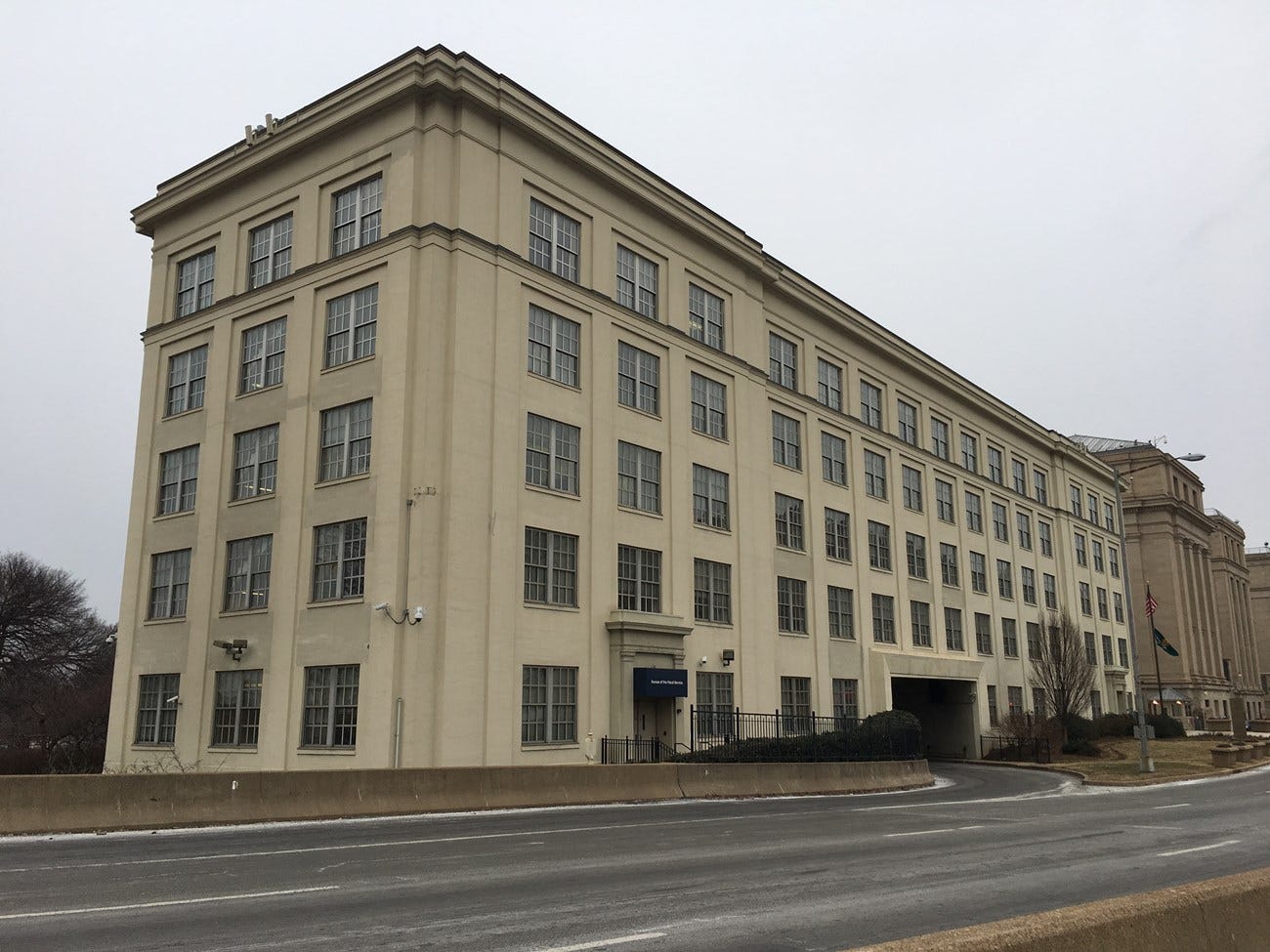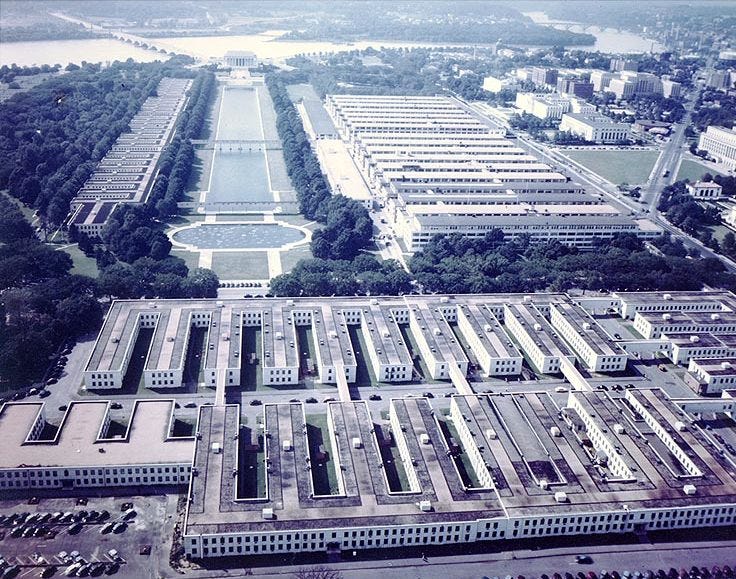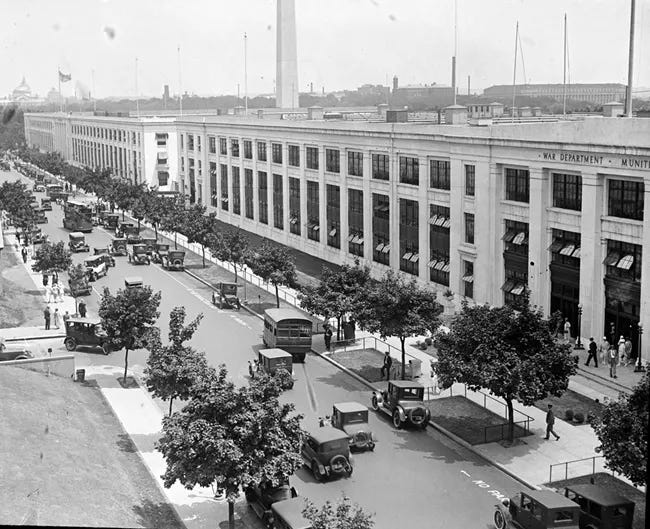Save the Last Tempo!
The Liberty Loan Building is an irreplaceable piece of the American Century
The news broke last month that the General Services Administration, the U.S. Government’s least-known and possibly most-powerful agency, essentially the Government’s property manager, plans on “disposing” of the old Liberty Loan Building, located just off the Tidal Basin, at 14th and D Sts., SW.
(The “last tempo”: the Liberty Loan Building; image from National Park Service.)
Normally, such an action would get little notice, but the building in question is no ordinary structure. Originally built in 1918, it is the last remaining “tempo” in Washington—one of the dozens built during World Wars I and II, mainly along the National Mall, to temporarily house the hundreds of thousands of workers who flooded into the Capital during those pivotal years.
(Tempos on the Mall in 1943-44; Navy and Munitions Buildings in center-right, between the Reflecting Pool and Constitution Avenue. Note walkway corridors spanning the Reflecting Pool. Image from the National Mall Coalition.)
I just published an opinion piece in The Washington Post, calling for the last tempo to be placed on the National Register of Historic Places. The article is probably paywalled, but its argument is a simple one: since the Liberty Loan Building is the only surviving representative of one of the most important groups of structures that helped create the American Century, it should be saved as a national site.
(Main Navy and War (Munitions) tempos, circa World War I, looking southeast; Smithsonian Museum of Natural History (then the National Museum) on far left, with the Capitol’s Statue of Freedom peeking out behind it. Image from National Park Service.)
For over half a century, the tempos defined the city as much as did the U.S. Capitol and Washington Monument. In particular, the massive Navy and Munitions buildings, along Constitution Avenue, symbolized America’s emergence as a great power. And if they were supposedly temporary, they nevertheless paved the way for the permanent monuments of American empire, including the Pentagon, the new Department of State, the CIA, and all the rest that symbolized America’s global power.
The tempos were not loved: they were utilitarian, quickly erected, quickly outdated, and they were a terrible eyesore on the Mall. Even FDR thought that he had “desecrated” the Mall by approving the construction of Main Navy back in 1917, as Assistant Secretary of the Navy. Despite all that, they endured from 1917 until 1971, when the last tempo but one was demolished. In their place rose the Smithsonian National Museum of American History and the Air and Space Museum, as well as Constitution Gardens, finally returning the Mall to the open space we all take for granted today.
What my Washington Post article could not discuss was how the GSA’s disposal process might go. Right now, the last tempo houses the Department of the Treasury’s Bureau of the Fiscal Service. According to the GSA, they will move the Fiscal Service out by next year. Then, the GSA has to decide what to do about the building. It’s over a century old, and was last given a major overhaul in the late-1980s. As a business space, the GSA believes it’s outlived its usefulness.
Disposal, however, doesn’t automatically mean selling it. Not surprisingly, there is a complicated process for selling federal “real property” that may have historic value. The good people at the DC Preservation League pointed me to Section 106 of the National Historic Preservation Act. According to the Advisory Council on Historic Preservation: “The Section 106 regulations state that the transfer or sale of a historic property out of federal ownership or control constitutes an adverse effect when undertaken without adequate and legally enforceable restrictions or conditions to ensure the long-term preservation of the property's historic significance. 36 C.F.R. § 800.5(a)(2)(vii).” Given that the GSA itself recognizes the historic character of the Liberty Loan Building, there is a good chance that the structure could be given some type of historic designation under Section 106, should the GSA determine it wants to sell the building.
There is another bureaucratic wrinkle, as well, which is that the Liberty Loan Building also falls under the jurisdiction of the Commission of Fine Arts, the powerful agency that is “charged with giving expert advice to the President, the Congress and the federal and District of Columbia governments on matters of design and aesthetics, as they affect the federal interest and preserve the dignity of the nation’s capital.” The Commission, founded in 1910, has long worked to ensure as much fidelity to the 1902 McMillan Plan as possible within the constraints of a rapidly growing downtown core.
The last tempo is considered a part of the Bureau of Engraving and Printing’s historic complex, as it backs onto the property, along the Tidal Basin. All of that is part of the CFA’s jurisdiction. This is good news, since it means no hasty decision can be made either about selling the building or allowing it to be sold unprotected.
In short, there should be a long road ahead before, in the worst-case scenario, a developer knocks down the last tempo and builds some glass-and-steel modernist replacement. That indeed may never happen, and it shouldn’t. The last tempo should be protected, not necessarily due to its own merit, but because it’s the final physical reminder of one of the most important eras in American history.
And, just in case things don’t go well for the last tempo, you might want to consider getting over to 401 14th St., SW, to see it for yourselves. There’s a good chance someone your parents or grandparents knew worked in it or one just like it.
Further reading: “Main Navy Building,” by the Naval History and Heritage Command; a good Washington Post article on the tempos by John Kelly is here. And, if you’re interested in helping save Washington’s historic structures, one of the best places to start is the DC Preservation League.




